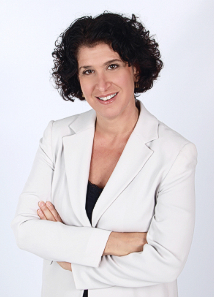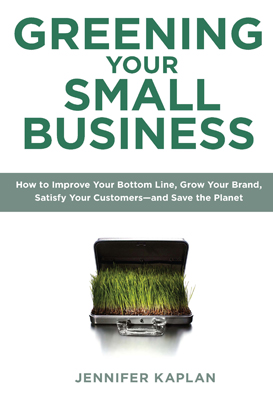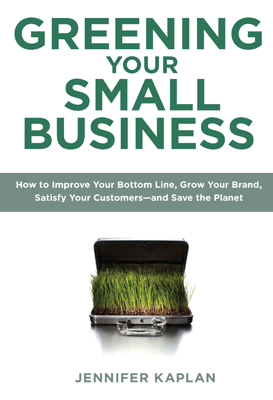Greening Your Small Business is a new book out this month by Jennifer Kaplan, a partner in Greenhance, a Washington, D.C.-based consulting firm working with large and small businesses to gain better insight into their impact on the environment. She also teaches at Marymount University’s business school in Arlington, Va.
 Courtesy Jennifer KaplanI talked to Kaplan about her new book and why she wrote it. Below are highlights from our discussion.
Courtesy Jennifer KaplanI talked to Kaplan about her new book and why she wrote it. Below are highlights from our discussion.
Q. Why did you see a need for this book?
Kaplan: I was teaching market research at Marymount, and one student was working with a business who needed help answering the question “How can I go green?” In researching the topic, I felt that there was a lot of information for homeowners and large corporations but not a lot for small businesses. A lot of the information was out there but it was very diffuse and no one had taken the time to compile it.
One of the people I talked to was the owner of Aspen Ski company who told me the resource book was a nice idea but a small idea. He said we need to talk about advocacy and leveraging the power of small businesses. That prompted me to include a whole section on getting involved with going green as a business and how to leverage it.
What is your definition of going green?
Kaplan: For the purposes of the book, it’s the implementation of a broad range of policies and procedures focused on conserving and improving the natural environment, both for its own sake as well as to improve business strength and sustainability.
How are large businesses different from small business in their needs for going green?
Kaplan: Most businesses are driven by the bottom line. They can’t afford to take losses for years and years. They have to take expenses into consideration and don’t necessarily have large resources. How one attacks “greening” in small businesses is on a smaller scale in efforts and activities. It’s appropriate to take more time and thoughtfulness and to consider all of your stakeholders. … A small business has to do it more subtly and in more incremental shifts. Where small business has leverage is that a lot of greening legislation and policy gets set at the local level. Small businesses can use their leverage to impact local recycling laws, for example.
How does going green empower a small business?
Kaplan: Being green for a small business has a tremendous amount of value in terms of creating a sustainable competitive advantage. I think it’s important to be honest and say, “This is what we’re doing, we’re constantly trying to improve.” In terms of how a business can position itself, there’s a number of things local firms can do. Get involved with a chamber of commerce, industry specific trade associations have green task forces where a small firm can push for green issues.
Can going green increase your business?
Kaplan: If there are two businesses and one is green and one isn’t, the environmentally conscious one is going to appeal to a certain population if everything else is on par. Now, you can’t be green and twice as expensive and be lower quality.
 Kaplan’s book was released on Nov. 3; it was published by Prentice Hall PressCourtesy Prentice Hall PressEvery company in some way or another is thinking about sustainability. Most think about ways to better the environment though the supply chain. If they can make a green purchase, having green vendors and suppliers is part of greening a small business.
Kaplan’s book was released on Nov. 3; it was published by Prentice Hall PressCourtesy Prentice Hall PressEvery company in some way or another is thinking about sustainability. Most think about ways to better the environment though the supply chain. If they can make a green purchase, having green vendors and suppliers is part of greening a small business.
How can a small business get over the “going green” inertia and start acting?
Kaplan: I have two pieces of advice. One is to start with something sexy. Changing to more energy efficient light bulbs is good but not particularly sexy. Getting reusable cups with a company logo is more sexy. You want something with high visibility that’s more interesting and fun. Getting involved with local green organization that holds an event is a good way to start.
The other thing is making small changes. Not every business is ready for a full-scale green strategy. You can start by walking around your office. Maybe you’ll say I can unplug the coffee makers in the break room because we only use it once a week. I can get rid of disposable cups and replace them with inexpensive ceramic ones. Next time I go to Staples I can get recycled pens, paper or paper clips at about the same cost as non recycled.
In the book, I outline a five-step process to create a small scale, low key greening plan. Start with a champion in the organization (who cold be the business owner but doesn’t have to be). Create a green team, which is often a team of one. Assess your current operations and write down what you’re already doing — like recycling. The list can be bigger than you realize when you put it all down.
Determine which practices can be changed with relative ease. I’m a big advocate of getting rid of fax machines. You use paper, toner, electricity and usually it eats up the cost of a separate phone line.
Small business owners and employees often wear so many hats it could be hard to add on this task.
Kaplan: Often within an organization there are people who feel passionate about this, but there are also a number of green human resources strategies. It’s true that if no one in the organization cares, it will be hard to do.
Are there any statistics or data that really wowed you when you were researching this book?
Kaplan: Having a single computer onsite can increase the use of electricity a business uses per square foot by 60 percent, and the percentage goes up as you add more computers. I thought how could that be, but if makes sense because if you have a computer, you have peripherals like a printer and modem, and you may have a person in that room who needs heating and ventilation. I have a whole chapter on energy management.
What do you say to the florist or butcher for example, who has invested hundreds if not thousands of dollars in refrigeration equipment that is not energy efficient and has a long lifespan, but they don’t have the finances to replace it.
Kaplan: There’s always trade offs and its one of the fundamental overarching questions. Do I get rid of low efficiency equipment and replace it? Do I rip out my linoleum floor and put in bamboo. I generally would say no. Don’t get rid of the deep freeze to replace them but you can in almost all cases retrofit and refurbish old equipment even through simple things like seal valves. Much of greening is simply reducing waste. Old things were often designed in a wasteful way. For example the U.S. [Environmental Protection Agency] has a program called GreenChill where it works with the supermarket industry to make grocery store refrigeration systems that were built years ago more efficient. One thing they found was that an average refrigeration tube was leaking 30 percent of its refrigerant and a simple solution was to wrap the tubes. The EPA offers free assessments in some cases.
What is single one thing that small business can do to think green?
Kaplan: A big theme of mine is to have a small business look for where it can reduce waste without buying a single new thing. Change your processes and practices. Are you wasting paper or using a fax machine. Using your scrap paper istead of buying Post-It notes. Are you wasteful in transportation? Can you cut back on expedited shipping? Are you renting small or midsize cars if you need a rental? Look at how you can involve savings without involving additional expenses.


